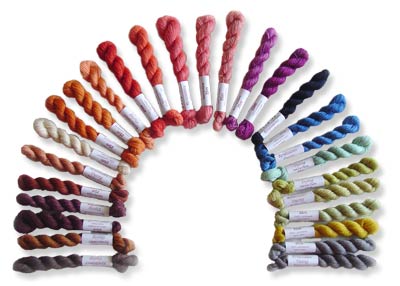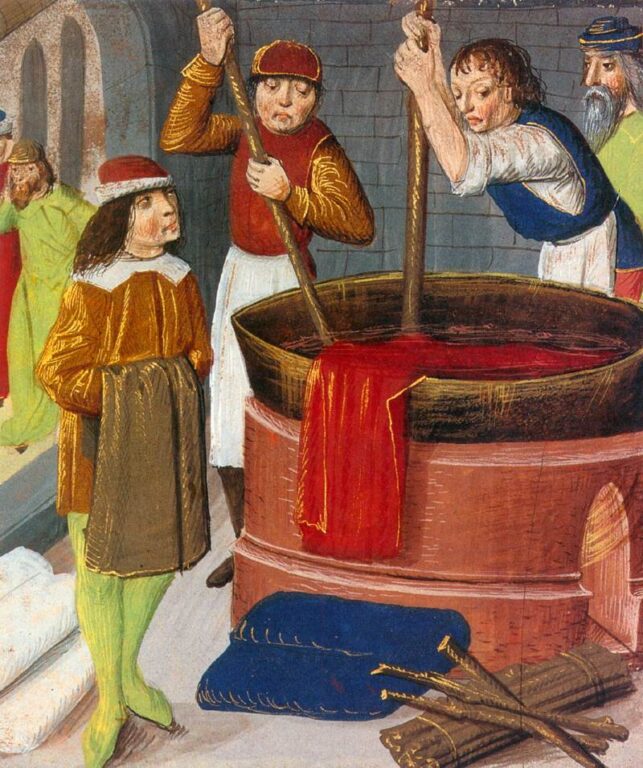Dyes have been an important substance to man since time immemorial and continue to be important as far as use is concerned. In fact, its use has only ever increased since its inception. However, the era that we are talking about had that one extra use for a dye and the colours it was available in.
The colour and brightness of a dye used on clothing during the Elizabethan era were most indicative of its cost and in doing so was almost definitely an indicator of your social and economic status. The brighter coloured dyes were more expensive and were more often than not worn by royalty and nobility alone whereas the more dull colours would belong to the economically weaker sections of society.

Cheap Dyes
Contents
Dyes were always made from natural sources in the Elizabeth era. There were generally four types of dyes in the cheap category during this time lichen, madder, woad and weld. Lichen was extracted from mosses and growths on the trunk of trees and was green in colour.
Madder was extracted from a European herb and provided a red tint to whatever clothing it applied. Woad was also made from a plant called Isatis tinctoria and provided a blue-tinted dyestuff from its leaves. Weld-on the other hand was a source of yellow dye. It was also called dyer’s rocket and dyer’s broom.

Lichen was made from a plant of the lichen category which grows in bushy or crusty places. They were the source of green colours.
In order to produce these colours, the dye was heated and the fabric was put into it. Other elements were also added to produce different shades of colour. Some of these elements were wine, vinegar, salt, lentils, fungus, shells, cucumbers, mosses etc. Certain dyes, such as woad, was produced by composting them with manure, which produced a terrible smell.
Expensive Dyes
Some of the more expensive dyes used were the Tyrian Purple dye which was made tediously by crushing seashells. The Indigo coloured dye was prepared from the Indigo plants. The crimson dye was extracted from the bodies of insects found in South or Central America or from the Mediterranean.
The rich yellow dye was prepared from Saffron. The purple clothing made by immersion in purple dyes were the most linked with royalty or nobility. However dull red or blue was often related to a downtrodden class of people.

Regardless of the social standing the preparation of dyes was an even more tedious process at that time than it is now and was a labour-intensive task. However, it was funny in a way that there were laws that forbade certain people to wear certain colours of clothing even if they could afford it simply because they were representative of a higher social class.
The Royal colours of England were Purple, crimson/scarlet, golden and in some cases silver. The poor people wore yellow, orange green, pink and pale blue. In the 16th century colours and shades also held certain connotations and significance, for example, the crimson colour was deeply associated with religions and had Biblical connotations. It was, thus, often used to represent saints and important religious figures.

Elizabethan Scarlet or Crimson dye
The crimson colour was produced from two things – the cochineal insect which was found in South America and kermes insect, found in the Mediterranean regions. The crimson, in fact, originated from kermes.
Elizabethan Deep Indigo / Blue
The indigo dye was a rich absorber and was a marker of wealth and class. It was only worn by the wealthy people of England. It must not be confused with blue which was produced from cheap dye extracted from woad.
The source of indigo dye was the indigo plant which was imported from India at a huge cost. The indigo dye was obtained by fermenting it, filtering it and finally drying them into cakes of colour.
Elizabethan Green dye
The green dye was derived from lichen plant which grows in bushy areas or on tree trunks and upon rock surfaces. It was used to produce clothes that were dyed in various shades of green.

Shakespeare Colours
The documentations made on the costumes worn by the actors in Shakespeare’s company also reveal information about colours: colours like scarlet, mulberry colour, sheep’s colour (natural), puke (dirty brown), watched (pale blue), lion’s colour (yellowish stain) are mentioned.
Orange-tawny was also a colour often used in the plays. Some other interesting Elizabethan colour names were: Gooseturb green, whey (pale bluish shade), Popongaie blue, Lustie Gallant, Biscay and Colour de Roy (colour worn by the knights and officials of the monarch of Scotland).
More Info On- Elizabethan Era Clothing Styles of different Classes, Colors and meanings
